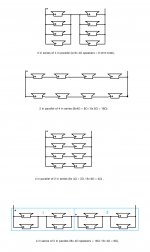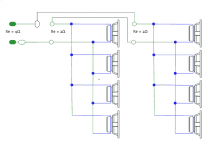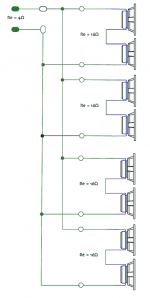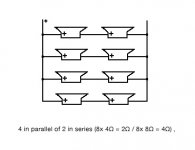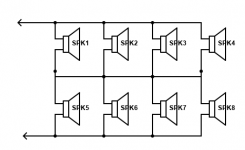Of the four possible ways to connect eight speakers (typically woofers) in series/parallel, there are conflicting views of preferred methods and even the total impedance - which you'd have thought would be straightforward. Some of these configurations are rare; others common. What say you?
Attachments
Last edited:
To keep the effective impedance the same, it's necessary to use either 1, 4, 9, 16, etc. drivers,
all connected symmetrically so each sees exactly the same voltage.
Use parallel groups of N drivers each, then with N of those groups connected in series.
all connected symmetrically so each sees exactly the same voltage.
Use parallel groups of N drivers each, then with N of those groups connected in series.
the way you wire them depends on amp capabilities, and the end sensitivity of the array. If you are going active it comes down to what your amp likes best.
Do note that many of your end nominal impedamces are wrong.
1/ 4 4Ω in parallel -> 1Ω, 2 in parallel -> 2Ω
2/ 4 4Ω in series -> 16Ω, 2 in parallel -> 8Ω
3/ 2 4Ω in series -> 8Ω, 4 in parallel -> 2Ω
4/ 2 4Ω in parallel ->2Ω, 4 in series -> 8Ω
Do you have specific drivers in mind… some, like the W14, come in 4, 8 or 16Ω which gives a larger set of end impedance/sensitivity options.
dave
Do note that many of your end nominal impedamces are wrong.
1/ 4 4Ω in parallel -> 1Ω, 2 in parallel -> 2Ω
2/ 4 4Ω in series -> 16Ω, 2 in parallel -> 8Ω
3/ 2 4Ω in series -> 8Ω, 4 in parallel -> 2Ω
4/ 2 4Ω in parallel ->2Ω, 4 in series -> 8Ω
Do you have specific drivers in mind… some, like the W14, come in 4, 8 or 16Ω which gives a larger set of end impedance/sensitivity options.
dave
If you achieve the same total impedance, the difference will be in what happens when a driver fails.
p.s. Dave is better with numbers than words. No.1 is 2 sets in series.
p.s. Dave is better with numbers than words. No.1 is 2 sets in series.
Depending on how the drivers are grouped in the enclosure by means of separate compartments, it can make a slight difference how they behave in the low end at their resonance. You will have an unfavorable interaction with 2 or more drivers in series, which can become a problem at higher power levels if driver Fs isn't well matched and this issue gets worse the more drivers you have connected in series if they're sharing the same air space.
Im not sure if this is obviois to most people, but I would always prefer to group the drivers in parallel if just one big enclosure is used and keep the series conncetions to a minimum. At the very least try to minimize the number of series groups, unless the drivers are closely matched.
Im not sure if this is obviois to most people, but I would always prefer to group the drivers in parallel if just one big enclosure is used and keep the series conncetions to a minimum. At the very least try to minimize the number of series groups, unless the drivers are closely matched.
If you achieve the same total impedance, the difference will be in what happens when a driver fails.
Thats a very valid point. If one driver in a parallel group fails (VC winding opens) and is in series with another prallel group, that group with the bad driver will see more power (voltage drop) than the other. That would accelerate the failure of the remaining drivers in the bad group.
On the other hand, if the VC shorted, the other parallel group would receive the full brunt of power.
These two scenarios would be rare given the higher power handling you obtain with drivers grouped in mixed series - parallel configuration, unless someone was blatantly careless with the volume control. The only practical time that sprt of failure would show up is with a random manufacturing defect with one of the drivers, which IMO would be rather rare.
...which can become a problem at higher power levels if driver Fs isn't well matched and this issue gets worse the more drivers you have connected in series
Why i measure and match the drivers.
dave
the way you wire them depends on amp capabilities, and the end sensitivity of the array. If you are going active it comes down to what your amp likes best.
Do note that many of your end nominal impedamces are wrong.
1/ 4 4Ω in parallel -> 1Ω, 2 in parallel -> 2Ω
2/ 4 4Ω in series -> 16Ω, 2 in parallel -> 8Ω
3/ 2 4Ω in series -> 8Ω, 4 in parallel -> 2Ω
4/ 2 4Ω in parallel ->2Ω, 4 in series -> 8Ω
Do you have specific drivers in mind… some, like the W14, come in 4, 8 or 16Ω which gives a larger set of end impedance/sensitivity options.
dave
Thanks for that. I'm playing around with 8x 8Ω drivers which want to arrive at 4Ω or 16Ω and which I need to be a 4Ω total.
In one folded baffle, scheme 1 (two series-connected sets of 4x paralleled drivers) models (and performs) with premature roll off. Modeling predicts much better performance around Fs with scheme 3 (four paralleled sets of 2x drivers in series).
However, despite both being 4Ω (as I understand it), my system is very unhappy about scheme 3, and the drivers howl shortly after (but not immediately on) power-up.
I don't see much online debating the pros and cons of different series/parallel configurations for more than four drivers.
Last edited:
That works OK, apart from the low end roll off.
What's wrong with 2x 8Ω in series (=16Ω), paralleled four times to give 4Ω - scheme 3? Evidently something, that I'm trying to understand!
What's wrong with 2x 8Ω in series (=16Ω), paralleled four times to give 4Ω - scheme 3? Evidently something, that I'm trying to understand!
If abstract numbers don't work for you, use coins, next to each other is parallel, on top of each other is series. You'll see how many ways you can get a given impedance.
If pictures worked for Feynman, they can work for you.
If pictures worked for Feynman, they can work for you.
What's wrong with 2x 8Ω in series (=16Ω), paralleled four times to give 4Ω - scheme 3?
That's ok, but connect all the center terminals together also.
Last edited:
That works too.
With 8 drivers you have 2 x 2 x 2, so when grouping things up you arrange those groups of 2 in diferent ways. A generalization of that is that the factorization of a number gives you the ways they can be connected.

Anything squared can be taken back to the original single driver impedance.
dave
With 8 drivers you have 2 x 2 x 2, so when grouping things up you arrange those groups of 2 in diferent ways. A generalization of that is that the factorization of a number gives you the ways they can be connected.
Anything squared can be taken back to the original single driver impedance.
dave
Attachments
I do appreciate all input on this, but - as well as exploring various ways of connecting 8 drivers in series/parallel - I wanted to nail down the best method in terms of performance around Fs.
In the post above you seem to contradict your post #9, by saying there is more than one way to connect 8x 8-ohm drivers to get a 4-ohm load (which is my goal). Please point out where I'm wrong, but the diagram above seems to be a more elaborate version of the scheme 3 diagram in the OP.

What's wrong with this picture?!
This is the version (4x parallel sets of 2x in series) that models better than the usually recommended scheme 1 (2x sets of 4 in parallel) but doesn't seem to be functional. If everyone confirms the topology is sound (this wiring scheme seems not to crop up in recommended configurations) I have to look elsewhere for the fault. If it's a non-starter for some reason I haven't grasped, it would help me, and might help others, to know.
When [rayma] you say 'center terminals', I'm assuming you mean the + > - connection between series pairs. Or have I misunderstood?
In the post above you seem to contradict your post #9, by saying there is more than one way to connect 8x 8-ohm drivers to get a 4-ohm load (which is my goal). Please point out where I'm wrong, but the diagram above seems to be a more elaborate version of the scheme 3 diagram in the OP.
What's wrong with this picture?!
This is the version (4x parallel sets of 2x in series) that models better than the usually recommended scheme 1 (2x sets of 4 in parallel) but doesn't seem to be functional. If everyone confirms the topology is sound (this wiring scheme seems not to crop up in recommended configurations) I have to look elsewhere for the fault. If it's a non-starter for some reason I haven't grasped, it would help me, and might help others, to know.
When [rayma] you say 'center terminals', I'm assuming you mean the + > - connection between series pairs. Or have I misunderstood?
Attachments
Last edited:
Yes, that's right. Try it if you have the chance, there is a distinct improvement in the sound
with those extra connections made, even with only 4 drivers total.
There's no problem with that picture. Maybe some of the polarities or other connections are wrong.
with those extra connections made, even with only 4 drivers total.
There's no problem with that picture. Maybe some of the polarities or other connections are wrong.
Last edited:
Yes, that's right. Try it if you have the chance, there is a distinct improvement in the sound
with those extra connections made, even with only 4 drivers total.
There's no problem with that picture. Maybe some of the polarities or other connections are wrong.
I suspected that and double-checked. Time for a triple-check! Or maybe a bad driver in the set: they are cheapo MCMs. But they worked fine in scheme 1.
No - that made it worse! When you say 'those extra connections', I'm guessing you don't mean the + > - links that are essential (to wire the driver pairs in series). Or do you mean to bi-wire them?
Also foxed by your 'centre terminals' - something other than +ve and -ve? Could you perhaps post a picture of your recommended tweak?
Last edited:
Husband, i was wrong, there are 2 qays to connect 8 8Ω to get 4Ω.
dave
Thanks for that clarification. Scheme 3 is rarely recommended for some reason: hard at this point not to combine its unpopularity with its propensity to break my amp (when the same drivers rearranged work fine) and conclude it's unworkable, although it seems fine. I'm still scratching my head.
Last edited:
When you say 'those extra connections', I'm guessing you don't mean the + > - links
that are essential (to wire the driver pairs in series)
Also foxed by your 'centre terminals' - something other than +ve and -ve? Could you
perhaps post a picture of your recommended tweak?
Think of this as one group of four parallel drivers, in series with another group of four parallel drivers.
This is the same as in post #9.
I still think there is a wiring error somewhere. None of these would harm your amp if it can drive 4R.
Unless the amp is very quirky about details of its load impedance.
Attachments
Last edited:
It's a Hypex Fusion plate amp. Fine with 2 series sets of 4 parallel, but makes a ghastly full volume howl with 4 parallel sets of 2 series. Not keen to repeat that.
This question was answered back in 2006, I just realised:
wiring 8 drivers together to achieve a 4 ohm load. | TalkBass.com
I'll check the amp with another driver and re-re-check the wiring.
Ah - that diagram makes more sense - but no idea what the amplifier sees that as - everything's connected to everything! Thanks again for your input.
This question was answered back in 2006, I just realised:
wiring 8 drivers together to achieve a 4 ohm load. | TalkBass.com
I'll check the amp with another driver and re-re-check the wiring.
Ah - that diagram makes more sense - but no idea what the amplifier sees that as - everything's connected to everything! Thanks again for your input.
Last edited:
- Home
- Loudspeakers
- Multi-Way
- 4 ways with 8 woofers: Series/Parallel / Parallel/Series
